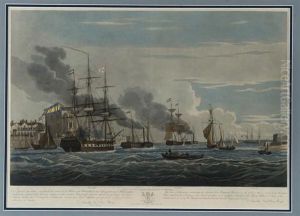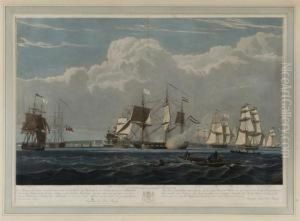John Alexander Schetky Paintings
John Alexander Schetky was a prominent Scottish marine artist, born in 1778 in Edinburgh, Scotland. He hailed from a family with a rich artistic and musical background, which significantly influenced his career path. Schetky's father, Alexander Schetky, was a respected musician and cellist, providing John with an environment that nurtured his creative talents from a young age. Despite this musical environment, it was in the visual arts that John Alexander Schetky found his true calling, particularly in painting marine scenes.
Schetky's education and early career were marked by his travels and studies in Europe, where he was exposed to various artistic styles and techniques. This period was crucial for the development of his distinctive style, which combined meticulous detail with a romantic sensibility toward the sea and maritime activities. His works often depicted ships, naval battles, and serene seascapes, capturing the dynamic and dramatic essence of the sea.
In the early 19th century, Schetky's reputation as a marine artist grew, and he became particularly well-known in the United Kingdom. His talent in capturing the majesty and peril of the sea resonated with the British public, especially during a time when naval power was a significant part of the nation's identity. Schetky's paintings were not only admired for their artistic merit but also valued for their historical and documentary detail, making them sought after by collectors and enthusiasts of naval history.
Throughout his career, John Alexander Schetky contributed significantly to the genre of marine art, influencing subsequent generations of artists. His works can be found in various prestigious collections and museums, attesting to his lasting legacy in the field of art. Schetky continued to paint and exhibit his work well into his later years, demonstrating a lifelong commitment to his art. He passed away in 1874, leaving behind a rich body of work that continues to be celebrated for its beauty, technical skill, and historical significance.

